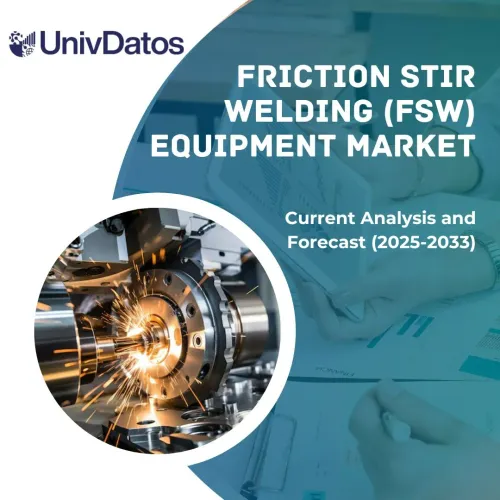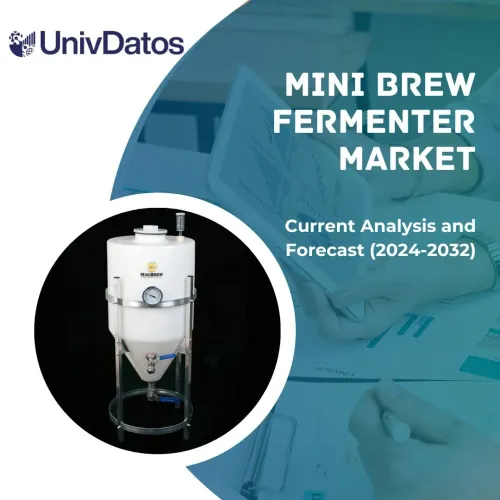- Home
- About Us
- Industry
- Services
- Reading
- Contact Us
Sensor Bearings Market: Current Analysis and Forecast (2024-2032)
Emphasis on Functionality (Speed, Temperature, Vibration, and Displacement); Application (Anti-lock Brake Systems (ABS), Electric Motors, Material Handling Equipment, and Others); End-User (Aerospace & Defense, Automotive, Metal & Mining, Oil & Gas, Transportation, and Others); and Region/Country
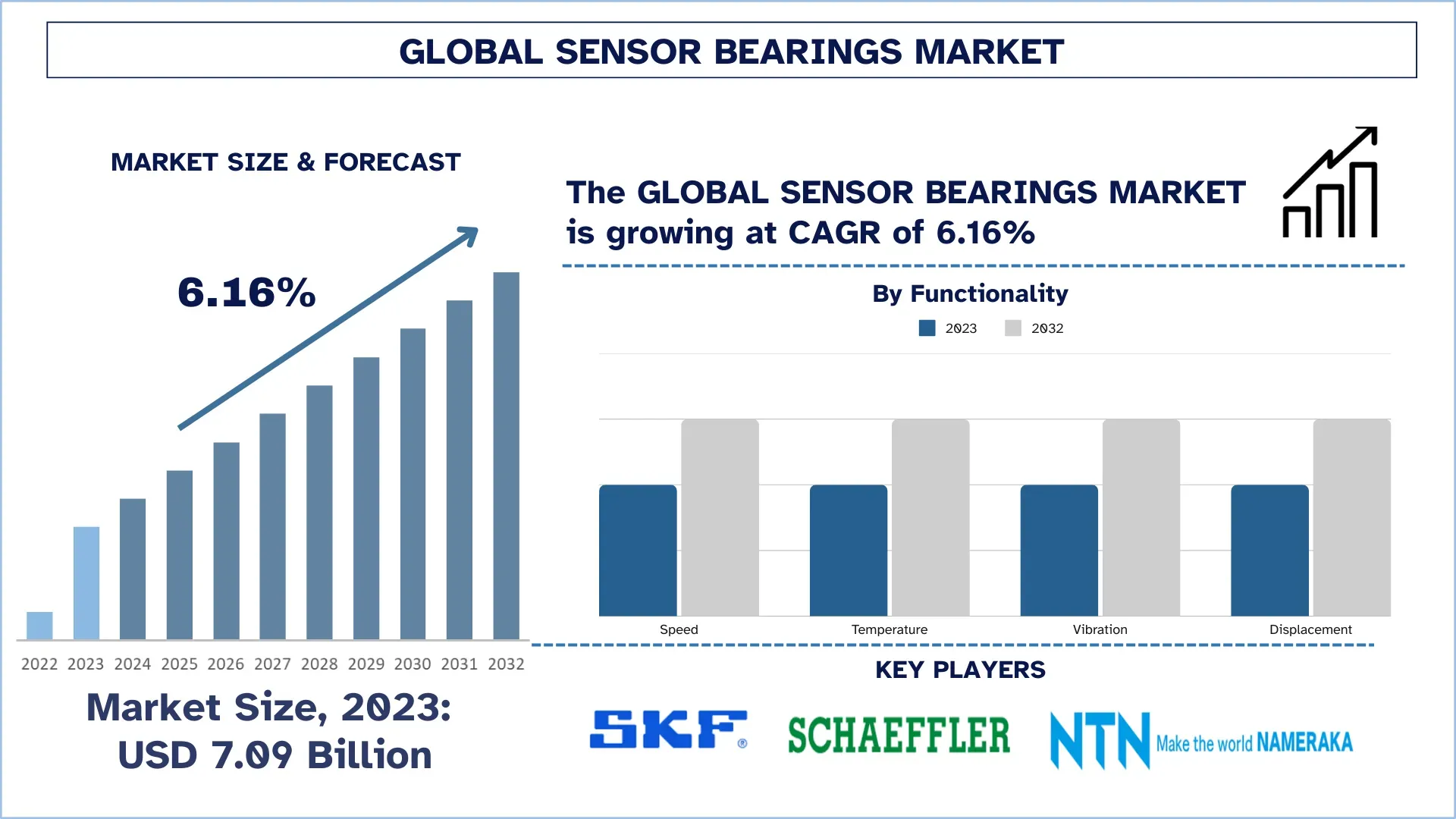
Sensor Bearings Market Size & Forecast
The Sensor Bearing Market was valued at USD 7.09 billion in 2023 and is expected to grow at a steady CAGR of around 6.16% during the forecast period (2024-2032). The increased demand in the automotive and aerospace industries and advancement in industrial automation are driving the demand for sensor bearings.
Sensor Bearings Market Analysis
The emerging tendency of sensor bearings and high-efficiency bearings across many industries such as automotive, aerospace, and machinery is rising. This booming demand is primarily towards controlling noise and vibration in the most modern applications, such as electric vehicles (EVs) and medical equipment. Also highly regarded in precision machines. The development of sensor bearings that bring sensing capabilities into the bearings to monitor operational parameters like temperature, vibration, and load is accelerating the growth of noise and vibration management, ultimately improving the functionality and reliability of both machinery and vehicles. Real-time monitoring and diagnostics make sensor bearings highly appreciated and lead to superior predictive maintenance and increased service life. These features are crucial in sectors where downtime is costly and safety care. For example, in the electric vehicle industry, sensor bearings are used for drivetrains and wheel hubs to reduce noise while improving component critical longevity and performance. The growing acceptance of electric vehicles and an upsurge in automation in industries such as manufacturing and robotics will also boost the demand for these bearings going forward.
Sensor Bearings Market Trends
Expansion of IoT and Wireless Sensor Integration
The increasing acceptance of IoT in industrial automation is giving significant transformation to applications based on sensor bearings. Wireless connectivity incorporates remote monitoring of equipment health by manufacturers with heightened efficiency and cut down on any downtime. SKF introduced INSIGHT+ technology, renowned in providing logic in this line, allowing for real-time data transmission and advanced analytics to facilitate predictive maintenance for heavy machinery and transport. For instance, in January 2023, NSXe Co. LTD., a Japan-based company providing services for mechanical equipment installation and maintenance, newly released a Wi-Fi vibration sensor, “conanair,” in the U.S. market.
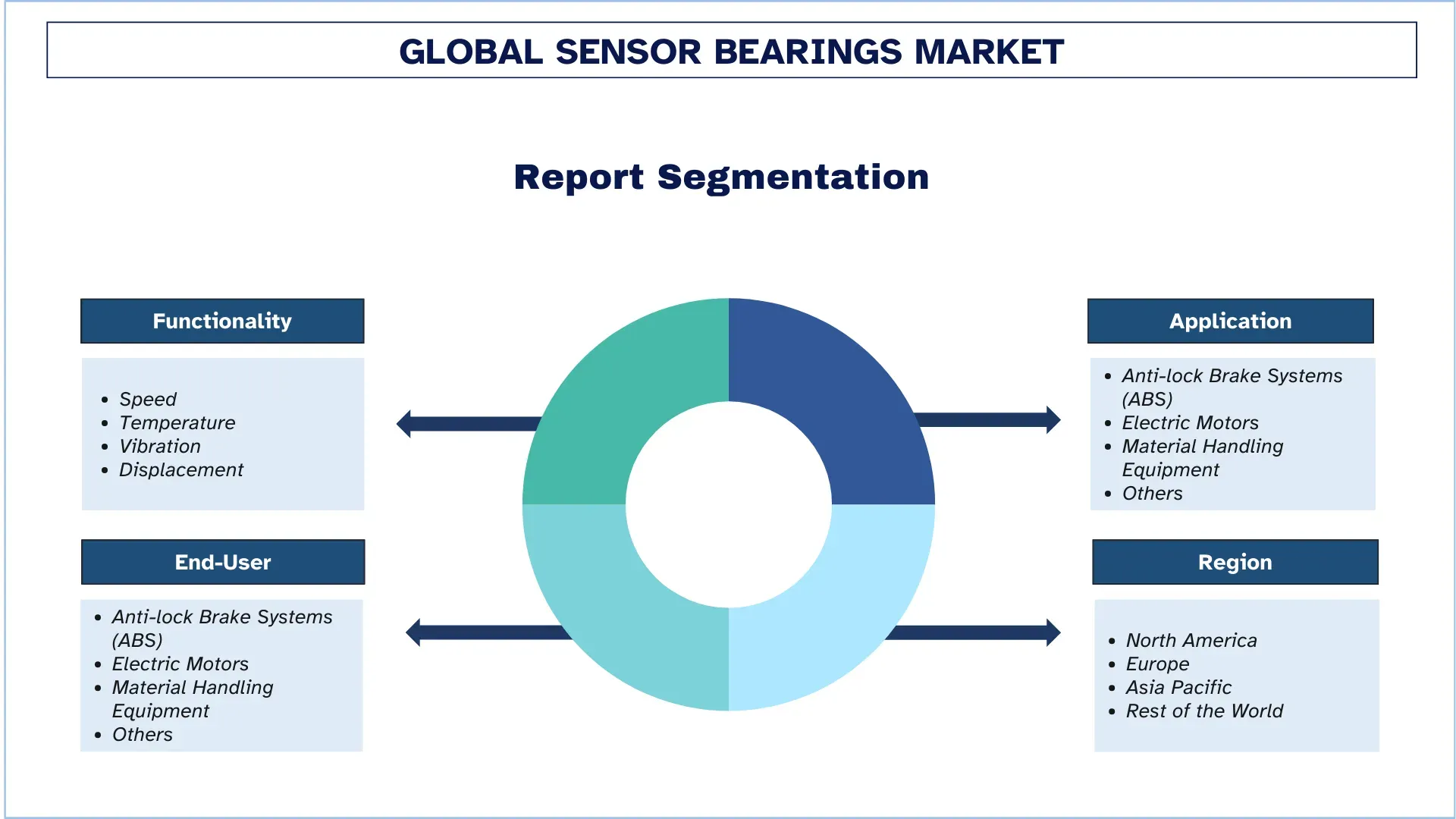
Asia Pacific Dominated the Sensor Bearings Market
The Asia-Pacific sensor bearings market is expected to dominate in the forecast period. The rapid industrialization, technological advancement, and rising demand for precision components in many industries are propelling the market. Automotive, electronics, and machinery industries in the region, especially in countries such as China, Japan, South Korea, and India, are attracting growth in this sector. Sensor bearings in China, being one of the main countries in the region, have found a pathway for high growth, being the largest automotive manufacturing hub in the region and a leading manufacturer of electric vehicles. Growth in demand is driven by government policies aimed at furthering EV adoption while reducing emissions and noise pollution, particularly for sensor bearings. The renewable energy sector in the Asia-Pacific region provides another impetus to the growth of the sensor bearings market. With about 180 GW of utility-scale solar and 159 GW of wind power presently on its drawing board, China is watching over the growth of renewables to cement its leadership worldwide. After an analysis of the current situation in renewables made by Global Energy Monitor (GEM), it was concluded that this double-handed total is adequate to electrify South Korea. Other than provincial subsidies, the market is driven, with many firms choosing sites close to headquarters. For example, battery giant CATL plans to develop its first offshore wind project in Fujian, its home province, to green the energy supply and comply with the EU Battery Regulation. Therefore, with the substantial growth of renewable energy such as wind and solar energy, the demand for sensor bearings in the region for effective and efficient operations. Furthermore, governments in the region are focusing on their economy and trying to make a production-based economy. To boost their manufacturing sectors, many governments in the region have introduced campaigns, such as the "Make in India" initiated by India and "Made in China 2025" in China. Such initiatives often come with subsidies and incentives for adopting newer manufacturing technologies, such as sensor bearings under precision engineering components.
Sensor Bearings Industry Overview
The sensor bearings market is competitive and concentrated, with few global and international players. The key players are adopting different growth strategies to enhance their market presence, such as partnerships, agreements, collaborations, new product launches, geographical expansions, and mergers and acquisitions. Some major players operating in the market are SKF Group, Schaeffler AG, NTN Corporation, The Timken Company, NSK Ltd., Fersa Bearings, Mageba, ABB, NBC Bearings, and Igus.
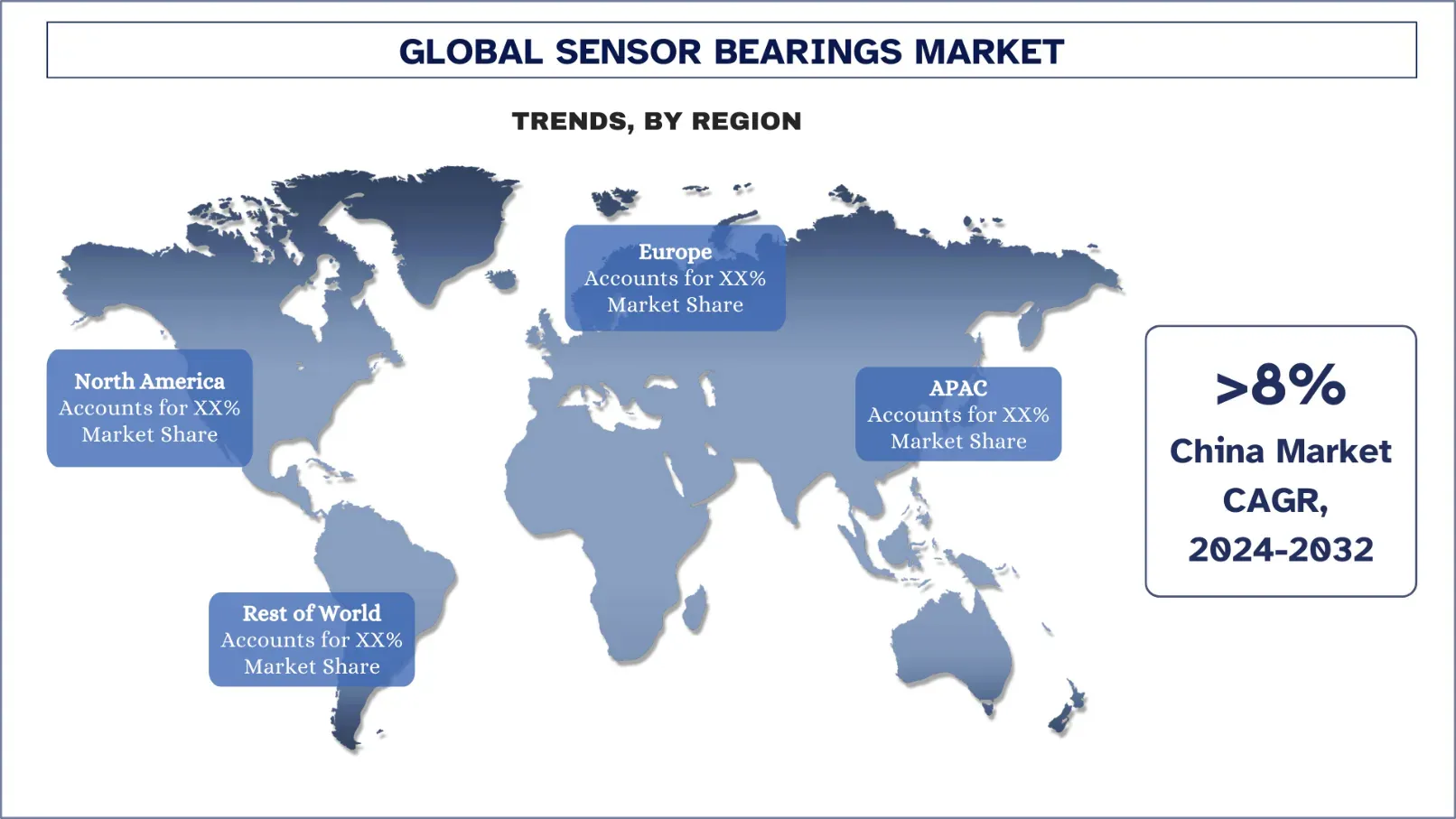
Sensor Bearings Market News
In June 2022, NTN Corporation, a Japanese-based company specialized in manufacturing sensor and other automotive components developed Sensor Integrated Bearing “Talking Bearing™” that incorporates sensors, power generation units, and wireless devices into bearing and wirelessly transmits information on temperature, vibration, and rotational speed.
In August 2023, RBC Bearings Incorporated, a US-based manufacturer of highly engineered precision bearings, components and essential systems for the industrial, defense and aerospace industries, acquired the business assets of Specline, Inc. a manufacturer of precision bearings for the commercial and defense aerospace markets for an amount of USD 18.7 million. The addition of Specline’s unique bearing and manufacturing processes increases the breadth of our aerospace product offering and enhances our production capacity.
In September 2023, NBC Bearings developed specialized low-noise bearings to specifically target NVH levels for EV applications. This will encompass motor and wheel hubs for electric two-wheelers. The company is ready to supply its electric motor sensor bearings that give sensor-level precision with real-time position information on the motor to the battery management system (BMS) of EVs.
Sensor Bearings Market Report Coverage
Report Attribute | Details |
Base year | 2023 |
Forecast period | 2024-2032 |
Growth momentum | Accelerate at a CAGR of 6.16% |
Market size 2023 | USD 7.09 billion |
Regional analysis | North America, Europe, APAC, Rest of the World |
Major contributing region | Asia Pacific dominated the market in 2023 |
Key countries covered | The US, Canada, Germany, The UK, Spain, Italy, France, China, Japan, and India |
Companies profiled | SKF Group, Schaeffler AG, NTN Corporation, The Timken Company, NSK Ltd., Fersa Bearings, Mageba, ABB, NBC Bearings, and Igus |
Report Scope | Market Trends, Drivers, and Restraints; Revenue Estimation and Forecast; Segmentation Analysis; Demand and Supply Side Analysis; Competitive Landscape; Company Profiling |
Segments Covered | By Functionality, By Application, By End-User, and By Region/Country |
Reasons to buy this report:
The study includes market sizing and forecasting analysis validated by authenticated key industry experts.
The report presents a quick review of overall industry performance at one glance.
The report covers an in-depth analysis of prominent industry peers with a primary focus on key business financials, product portfolios, expansion strategies, and recent developments.
Detailed examination of drivers, restraints, key trends, and opportunities prevailing in the industry.
The study comprehensively covers the market across different segments.
Deep dive regional level analysis of the industry.
Customization Options:
The global sensor bearings market can further be customized as per the requirement or any other market segment. Besides this, UMI understands that you may have your own business needs, hence feel free to contact us to get a report that completely suits your requirements.
Table of Content
Research Methodology for the Sensor Bearings Market Analysis (2024-2032)
Analyzing the historical market, estimating the current market, and forecasting the future market of the global sensor bearings market were the three major steps undertaken to create and analyze the adoption of sensor bearings in major regions globally. Exhaustive secondary research was conducted to collect the historical market numbers and estimate the current market size. Secondly, to validate these insights, numerous findings and assumptions were taken into consideration. Moreover, exhaustive primary interviews were also conducted with industry experts across the value chain of the global sensor bearings market. Post assumption and validation of market numbers through primary interviews, we employed a top-down/bottom-up approach to forecasting the complete market size. Thereafter, market breakdown and data triangulation methods were adopted to estimate and analyze the market size of segments and sub-segments of the industry pertains to. Detailed methodology is explained below:
Analysis of Historical Market Size
Step 1: In-Depth Study of Secondary Sources:
Detailed secondary study was conducted to obtain the historical market size of the sensor bearings through company internal sources such as annual reports & financial statements, performance presentations, press releases, etc., and external sources including journals, news & articles, government publications, competitor publications, sector reports, third-party database, and other credible publications.
Step 2: Market Segmentation:
After obtaining the historical market size of the sensor bearings market, we conducted a detailed secondary analysis to gather historical market insights and share for different segments & sub-segments for major regions. Major segments included in the report are functionality, application, and end-user. Further country-level analyses were conducted to evaluate the overall adoption of testing models in that region.
Step 3: Factor Analysis:
After acquiring the historical market size of different segments and sub-segments, we conducted a detailed factor analysis to estimate the current market size of the sensor bearings. Further, we conducted factor analysis using dependent and independent variables such as functionality, application, and end-user of the sensor bearings market. A thorough analysis was conducted of demand and supply-side scenarios considering top partnerships, mergers and acquisitions, business expansion, and product launches in the sensor bearings market sector across the globe.
Current Market Size Estimate & Forecast
Current Market Sizing: Based on actionable insights from the above 3 steps, we arrived at the current market size, key players in the global sensor bearings market, and market shares of the segments. All the required percentage shares split, and market breakdowns were determined using the above-mentioned secondary approach and were verified through primary interviews.
Estimation & Forecasting: For market estimation and forecast, weights were assigned to different factors including drivers & trends, restraints, and opportunities available for the stakeholders. After analyzing these factors, relevant forecasting techniques i.e., the top-down/bottom-up approach were applied to arrive at the market forecast for 2032 for different segments and sub-segments across the major markets globally. The research methodology adopted to estimate the market size encompasses:
The industry’s market size, in terms of revenue (USD) and the adoption rate of the sensor bearings market across the major markets domestically
All percentage shares, splits, and breakdowns of market segments and sub-segments
Key players in the global sensor bearings market in terms of products offered. Also, the growth strategies adopted by these players to compete in the fast-growing market.
Market Size and Share Validation
Primary Research: In-depth interviews were conducted with the Key Opinion Leaders (KOLs) including Top Level Executives (CXO/VPs, Sales Head, Marketing Head, Operational Head, Regional Head, Country Head, etc.) across major regions. Primary research findings were then summarized, and statistical analysis was performed to prove the stated hypothesis. Inputs from primary research were consolidated with secondary findings, hence turning information into actionable insights.
Split of Primary Participants in Different Regions
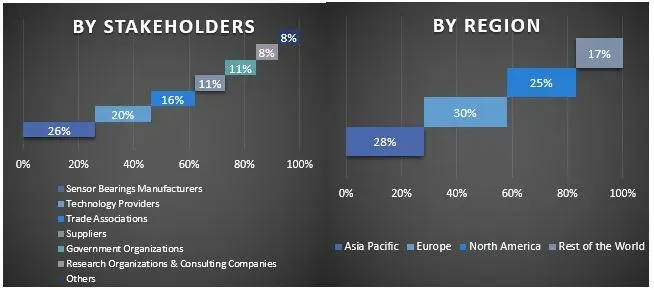
Market Engineering
The data triangulation technique was employed to complete the overall market estimation and to arrive at precise statistical numbers for each segment and sub-segment of the global sensor bearings market. Data was split into several segments & sub-segments post studying various parameters and trends in the areas of the functionality, application, and end-user in the global sensor bearings market.
The main objective of the Global Sensor Bearings Market Study
The current & future market trends of the global sensor bearings market were pinpointed in the study. Investors can gain strategic insights to base their discretion for investments on the qualitative and quantitative analysis performed in the study. Current and future market trends determined the overall attractiveness of the market at a regional level, providing a platform for the industrial participant to exploit the untapped market to benefit from a first-mover advantage. Other quantitative goals of the studies include:
Analyze the current forecast and market size of the sensor bearings market in terms of value (USD). Also, analyze the current forecast and market size of different segments and sub-segments.
Segments in the study include areas of functionality, application, and end-user.
Define and analysis of the regulatory framework for the sensor bearings
Analyze the value chain involved with the presence of various intermediaries, along with analyzing customer and competitor behaviors of the industry.
Analyze the current forecast and market size of the sensor bearings market for the major region.
Major countries of regions studied in the report include Asia Pacific, Europe, North America, and the Rest of the World
Company profiles of the sensor bearings market and the growth strategies adopted by the market players to sustain the fast-growing market.
Deep dive regional level analysis of the industry
Frequently Asked Questions FAQs
Q1: What is the current market size and growth potential of the sensor bearings market?
The sensor bearings market was valued at USD 7.09 billion in 2023 and is expected to grow at a CAGR of 6.16% during the forecast period (2024-2032).
Q2: What are the driving factors for the growth of the sensor bearings market?
The increased demand in the automotive and aerospace industries and advancement in industrial automation are driving the demand for sensor bearings.
Q3: Which segment has the largest sensor bearing market share by Functionality?
The speed segment has the largest sensor bearing market share by Functionality.
Q4: What are the emerging technologies and trends in the sensor bearings market?
The Expansion of IoT and Wireless Sensor Integration in the sensor bearings is one of the significant trends in the sensor bearings market.
Q5: Which region will dominate the sensor bearings market?
Asia Pacific is expected to dominate the market during the forecast period.
Related Reports
Customers who bought this item also bought

